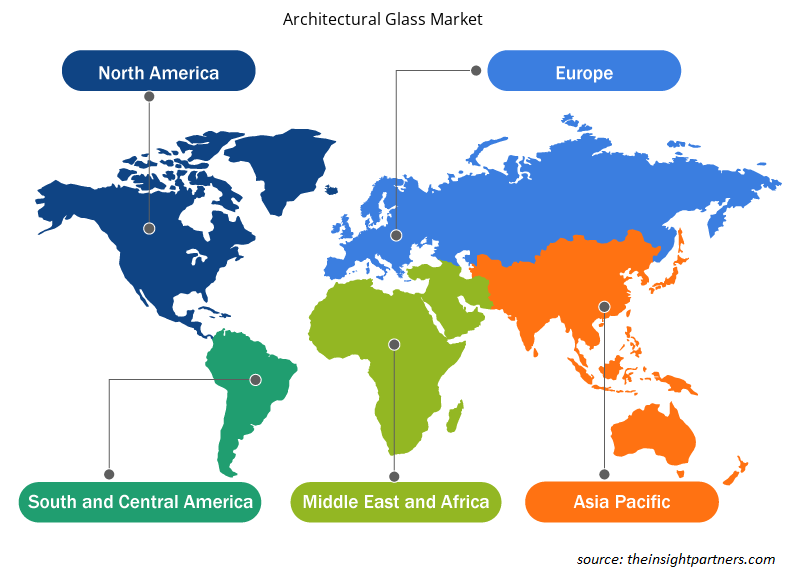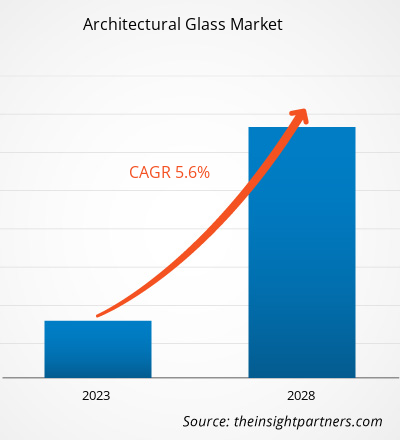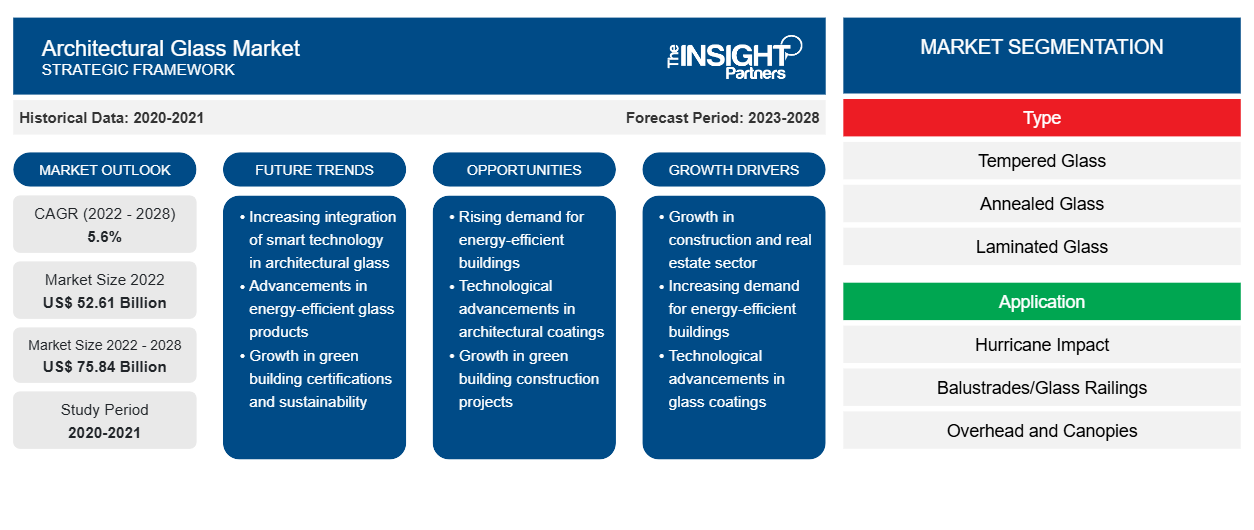Si prevede che il mercato del vetro architettonico crescerà da 52.608,27 milioni di dollari nel 2022 a 75.837,41 milioni di dollari entro il 2028; si prevede una crescita a un CAGR del 5,6% dal 2022 al 2028.
Il vetro architettonico è un materiale da costruzione utilizzato come materiale di vetratura trasparente in finestre, porte di case e uffici, pareti esterne, tra gli altri. La crescente urbanizzazione sta contribuendo alle crescenti attività di costruzione in tutto il mondo. La crescente crescita della popolazione, la migrazione di persone dalle aree rurali a quelle urbane per opportunità di carriera e gli investimenti aziendali strategici stanno stimolando il settore delle costruzioni, guidando la crescita del mercato del vetro architettonico .
Impatto della pandemia di COVID-19 sul mercato del vetro architettonico
Nel 2020, vari settori hanno dovuto rallentare le proprie attività a causa di interruzioni nelle catene di valore e di fornitura causate dalla chiusura dei confini nazionali e internazionali. La pandemia di COVID-19 ha avuto un impatto negativo sulle economie e sui settori a causa di lockdown, divieti di viaggio e chiusure aziendali. Le interruzioni nelle catene di fornitura di materie prime chiave e le irregolarità nei processi di produzione dovute alle restrizioni imposte dalle autorità governative hanno avuto un impatto diretto sul settore dei prodotti chimici e dei materiali, ostacolando la produzione e la domanda di materiali da costruzione. Questi fattori hanno avuto un impatto negativo sul mercato del vetro architettonico durante la pandemia di COVID-19. Tuttavia, nel 2021, il mercato ha assistito a una ripresa positiva poiché i governi hanno annunciato l'allentamento delle restrizioni precedentemente imposte. Ai produttori è stato consentito di lavorare a piena capacità, sfruttando la loro redditività. Si prevede che questo fattore guiderà il mercato nei prossimi anni. Ad esempio, secondo Eurostat, dopo un calo senza precedenti a marzo e aprile (-25,9%), l'attività edilizia nell'Unione europea è aumentata del 20,4% a maggio 2020. Ha recuperato alcune delle perdite della crisi. Da allora, l'attività edilizia è aumentata nella maggior parte dei mesi, ma non in modo molto dinamico. A gennaio 2022, il livello di produzione era solo dell'1,9% più alto rispetto a febbraio 2020.
Personalizza questo report in base alle tue esigenze
Riceverai la personalizzazione gratuita di qualsiasi report, comprese parti di questo report, o analisi a livello nazionale, pacchetto dati Excel, oltre a usufruire di grandi offerte e sconti per start-up e università
-
Scopri le principali tendenze di mercato in questo rapporto.Questo campione GRATUITO includerà analisi di dati che spaziano dalle tendenze di mercato alle stime e alle previsioni.
Approfondimenti di mercato
Crescente domanda di vetro colorato e stampato
Con la crescita economica, l'aumento degli standard di vita e la modernizzazione della popolazione a livello globale, l'uso del vetro decorativo, come il vetro stampato e colorato, nella progettazione degli interni di edifici residenziali e commerciali è in aumento. La domanda di vetro serigrafato nel settore edile è in crescita poiché offre vari vantaggi estetici rispetto ai materiali da costruzione tradizionali. Il vetro serigrafato amplia i suoi utilizzi in applicazioni industriali, commerciali e architettoniche come vetrine, paesaggistica esterna di edifici, partizioni di spazi architettonici, vetro a mosaico, decorazione di mobili e altri oggetti 3D. Si prevede che tale progresso nelle varietà di produzione del vetro aumenterà ulteriormente la domanda di vetro architettonico.
Tipo Informazioni
In base al tipo, il mercato del vetro architettonico è suddiviso in vetro temperato , vetro ricotto, vetro laminato e altri. Si prevede che il segmento laminato registrerà il CAGR più elevato durante il periodo di previsione. Il vetro laminato è una buona alternativa al vetro tradizionale, in quanto offre una struttura rigida, robusta e durevole e fornisce uno strato solido e trasparente. Viene utilizzato in edifici ad alto rischio di uragani o altri disastri naturali, in finestre di edifici residenziali e commerciali ad alto rischio di effrazioni, in vetrine per oggetti di valore come gioielli, acquari o recinti per animali, pavimenti in vetro, scale in vetro, lucernari e tetti in vetro. Inoltre, a causa della crescente domanda di sicurezza, riduzione del rumore, resistenza alla rottura e protezione da condizioni meteorologiche avverse, si prevede che il mercato assisterà a una crescita costante durante il periodo di previsione.
Approfondimenti sulle applicazioni
In base all'applicazione, il mercato del vetro architettonico è segmentato in vetro antiuragano, balaustre/ringhiere in vetro, pensiline e pensiline, vetro di sicurezza/antiproiettile, acustico, vetro decorativo/colorato, facciate strutturali e altri. Il segmento delle facciate strutturali ha detenuto la quota maggiore del mercato nel 2021. Nelle facciate strutturali , il vetro architettonico è ampiamente utilizzato nei rivestimenti di pareti in vetro e nelle pareti divisorie in vetro. Il rivestimento delle pareti è utilizzato per fornire un certo grado di isolamento termico e resistenza alle intemperie e per migliorare l'aspetto degli edifici. Il rivestimento in vetro è una tecnica ampiamente utilizzata in architettura in cui i pannelli di vetro vengono utilizzati sulla superficie esterna degli edifici. Il vetro temperato è il tipo di vetro più comune utilizzato nelle pareti divisorie. Questo vetro viene temperato riscaldandolo, il che lo rende da quattro a cinque volte più resistente e durevole del vetro ricotto. Si prevede che questi fattori guideranno il segmento.
I principali attori che operano nel mercato del vetro architettonico includono AGC Inc, Compagnie de Saint-Gobain SA, Guardian Industries Holdings LLC, Nippon Sheet Glass Co Ltd, Qingdao Morn Building Materials Co Ltd, Asahi India Glass Ltd, Turkiye Sise ve Cam Fabrikalari AS, Schott AG, Jinjing (Group) Co Ltd e Vitro SAB de CV. Questi attori si concentrano sulla fornitura di prodotti di alta qualità per soddisfare le richieste dei clienti. Si concentrano anche su strategie come investimenti in attività di ricerca e sviluppo e lanci di nuovi prodotti.
Approfondimenti regionali sul mercato del vetro architettonico
Le tendenze regionali e i fattori che influenzano il mercato del vetro architettonico durante il periodo di previsione sono stati ampiamente spiegati dagli analisti di Insight Partners. Questa sezione discute anche i segmenti e la geografia del mercato del vetro architettonico in Nord America, Europa, Asia Pacifico, Medio Oriente e Africa e America meridionale e centrale.

- Ottieni i dati specifici regionali per il mercato del vetro architettonico
Ambito del rapporto sul mercato del vetro architettonico
| Attributo del report | Dettagli |
|---|---|
| Dimensioni del mercato nel 2022 | 52,61 miliardi di dollari USA |
| Dimensioni del mercato entro il 2028 | 75,84 miliardi di dollari USA |
| CAGR globale (2022 - 2028) | 5,6% |
| Dati storici | 2020-2021 |
| Periodo di previsione | 2023-2028 |
| Segmenti coperti |
Per tipo
|
| Regioni e Paesi coperti |
America del Nord
|
| Leader di mercato e profili aziendali chiave |
|
Densità degli attori del mercato del vetro architettonico: comprendere il suo impatto sulle dinamiche aziendali
Il mercato del vetro architettonico sta crescendo rapidamente, spinto dalla crescente domanda degli utenti finali dovuta a fattori quali l'evoluzione delle preferenze dei consumatori, i progressi tecnologici e una maggiore consapevolezza dei vantaggi del prodotto. Con l'aumento della domanda, le aziende stanno ampliando le loro offerte, innovando per soddisfare le esigenze dei consumatori e capitalizzando sulle tendenze emergenti, il che alimenta ulteriormente la crescita del mercato.
La densità degli operatori di mercato si riferisce alla distribuzione di aziende o società che operano in un particolare mercato o settore. Indica quanti concorrenti (operatori di mercato) sono presenti in un dato spazio di mercato in relazione alle sue dimensioni o al valore di mercato totale.
Le principali aziende che operano nel mercato del vetro architettonico sono:
- AGC Inc
- Compagnia di Saint-Gobain SA
- Società a responsabilità limitata Guardian Industries Holdings LLC
- Nippon Sheet Glass Co Ltd
- Materiali edili Qingdao Morn Co Ltd
Disclaimer : le aziende elencate sopra non sono classificate secondo un ordine particolare.

- Ottieni una panoramica dei principali attori del mercato del vetro architettonico
Segnala i riflettori
- Tendenze industriali progressive nel mercato del vetro architettonico per aiutare gli operatori a sviluppare strategie efficaci a lungo termine
- Strategie di crescita aziendale adottate dalle aziende per garantire la crescita nei mercati sviluppati e in via di sviluppo
- Analisi quantitativa del mercato del vetro architettonico dal 2020 al 2028
- Stima della domanda globale di vetro architettonico
- Analisi delle cinque forze di Porter per illustrare l'efficacia degli acquirenti e dei fornitori di vetro architettonico
- Sviluppi recenti per comprendere lo scenario competitivo del mercato
- Tendenze e prospettive del mercato, insieme ai fattori che guidano e frenano la crescita del mercato del vetro architettonico
- Assistenza nel processo decisionale evidenziando le strategie di mercato che sostengono l'interesse commerciale
- La dimensione del mercato del vetro architettonico nei vari nodi
- Panoramica dettagliata e segmentazione del mercato, nonché dinamiche del settore delle costruzioni
- Dimensioni del mercato del vetro architettonico in varie regioni con promettenti opportunità di crescita
Profili aziendali
- AGC Inc
- Compagnia di Saint-Gobain SA
- Società a responsabilità limitata Guardian Industries Holdings LLC
- Nippon Sheet Glass Co Ltd
- Materiali edili Qingdao Morn Co Ltd
- Vetro Asahi India Ltd
- Turkiye Sise ve Cam Fabrikalari AS
- Azienda Schott
- Jinjing (gruppo) Co Ltd
- Vitro SAB di CV
- Analisi storica (2 anni), anno base, previsione (7 anni) con CAGR
- Analisi PEST e SWOT
- Valore/volume delle dimensioni del mercato - Globale, Regionale, Nazionale
- Industria e panorama competitivo
- Set di dati Excel
Report recenti
Rapporti correlati
Testimonianze
Motivo dell'acquisto
- Processo decisionale informato
- Comprensione delle dinamiche di mercato
- Analisi competitiva
- Analisi dei clienti
- Previsioni di mercato
- Mitigazione del rischio
- Pianificazione strategica
- Giustificazione degli investimenti
- Identificazione dei mercati emergenti
- Miglioramento delle strategie di marketing
- Aumento dell'efficienza operativa
- Allineamento alle tendenze normative























 Ottieni un campione gratuito per - Mercato del vetro architettonico
Ottieni un campione gratuito per - Mercato del vetro architettonico